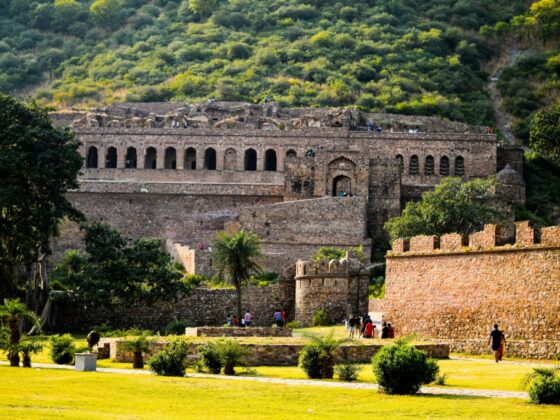Ancient Rajput Forts: The Legacy of Valor and Architecture

Introduction
The Rajput forts of India stand as living monuments of valor, resilience, and artistic excellence. Built between the 7th and 18th centuries, these colossal structures were more than just military strongholds; they were centers of governance, culture, and Rajput pride. Situated in Rajasthan, Madhya Pradesh, and Gujarat, these forts narrate the tales of heroic battles, strategic defenses, and intricate architectural styles blending Rajput, Mughal, and Persian influences. This article explores the legacy of Rajput forts, their unique construction techniques, and their enduring significance in Indian history.
Architectural Brilliance of Rajput Forts
Ancient Rajput forts were designed with defensive mechanisms, towering walls, hidden escape routes, and water conservation systems. They were strategically located on hills, deserts, or riverbanks to enhance their defensive capabilities. Some of the most prominent architectural features include:
- Massive Walls & Bastions – Built using sandstone, granite, and marble, these walls could withstand prolonged sieges.
- Zigzag Entrances – Designed to prevent direct enemy charges, making invasions difficult.
- Secret Tunnels & Escape Routes – Used to evacuate the royal family in times of attack.
- Stepwells & Water Harvesting Systems – Ensured a consistent water supply during long sieges.
- Intricate Palaces & Temples – Showcased Rajput artistry, with elaborate carvings, frescoes, and mirror work.
Famous Rajput Forts and Their Legacy
1. Chittorgarh Fort – The Citadel of Valor
Chittorgarh Fort, the largest fort in India, is a symbol of Rajput bravery and resistance. It was home to legendary warriors like Maharana Pratap and Rani Padmini. The fort has witnessed multiple sieges, including attacks by Alauddin Khilji and Bahadur Shah. Key attractions within the fort include:
- Vijay Stambh (Tower of Victory) – Built by Rana Kumbha to commemorate his victory over Mahmud Khilji.
- Rani Padmini’s Palace – The legendary site of Alauddin Khilji’s ill-fated obsession.
- Kirti Stambh – A symbol of Jain heritage, showcasing exquisite craftsmanship.
2. Mehrangarh Fort – The Majestic Stronghold
Overlooking Jodhpur, Mehrangarh Fort is one of the most formidable Rajput forts. Built by Rao Jodha in 1459, this fort remains a testament to Rajput engineering and artistry. Notable features include:
- Seven Massive Gates – Each gate commemorates a Rajput victory in battle.
- Moti Mahal (Pearl Palace) – An architectural gem with vibrant glass windows.
- Sheesh Mahal – A stunning hall adorned with intricate mirror work.
3. Kumbhalgarh Fort – The Great Wall of India
Renowned for having the second-largest continuous wall in the world, Kumbhalgarh Fort was built by Rana Kumbha in the 15th century. It served as a refuge for Maharana Pratap during his struggles against the Mughals. Major highlights include:
- 36-km-long fortification walls – Second only to the Great Wall of China.
- Badal Mahal (Cloud Palace) – Offers panoramic views of the Aravalli Hills.
- Ancient Jain and Hindu temples – Showcasing religious harmony and artistic brilliance.
4. Amber Fort – A Blend of Rajput and Mughal Architecture
Located near Jaipur, Amber Fort is known for its fusion of Rajput and Mughal architectural styles. Built in the 16th century by Raja Man Singh, the fort features:
- Sheesh Mahal (Hall of Mirrors) – Famous for its intricate mirror mosaic work.
- Ganesh Pol – An ornately painted gateway leading to the royal residences.
- Maota Lake – Enhancing the fort’s scenic beauty and serving as a water reservoir.
5. Jaisalmer Fort – The Living Fortress
Unlike other forts, Jaisalmer Fort is a living fort, still inhabited by local communities. Built in 1156 by Rawal Jaisal, this golden-hued structure blends into the Thar Desert landscape. Attractions inside the fort include:
- Nathmal Ki Haveli & Patwon Ki Haveli – Lavish mansions showcasing Rajput craftsmanship.
- Jain Temples – Richly carved shrines with delicate marble and sandstone motifs.
- Sunset Point – Offering breathtaking views of the desert expanse.
Cultural and Historical Significance
Rajput forts are more than just architectural masterpieces; they embody the ethos of chivalry, sacrifice, and self-respect. These forts witnessed:
- Jauhar and Saka traditions – Acts of supreme sacrifice by Rajput women and warriors to uphold their honor.
- Diplomatic Alliances – Some forts played key roles in Rajput-Mughal relations, influencing India’s political landscape.
- Festivals & Cultural Events – Today, many forts host annual festivals like the Jaisalmer Desert Festival and Kumbhalgarh Festival, celebrating their legacy.
UNESCO Recognition and Preservation Efforts
Several Rajput forts, including Chittorgarh, Kumbhalgarh, and Amber, have been recognized as UNESCO World Heritage Sites under the Hill Forts of Rajasthan group. Preservation efforts include:
- Government-led restoration projects to prevent structural decay.
- Tourism promotion initiatives to boost awareness and appreciation of Rajput heritage.
- Archaeological research to uncover hidden historical insights.
Conclusion
The ancient Rajput forts stand as indomitable symbols of India’s glorious past, blending military strategy with artistic excellence. From Chittorgarh’s valor to Mehrangarh’s majesty, each fort tells a unique story of heroism and architectural brilliance. Today, they continue to inspire historians, architects, and travelers alike, preserving the unwavering spirit of the Rajputs for generations to come.
Visiting these forts is not just a journey into history but a tribute to the legacy of courage, honor, and heritage that defines India’s royal past.






